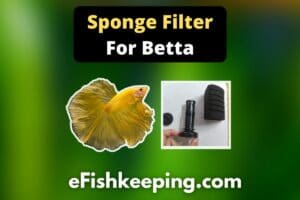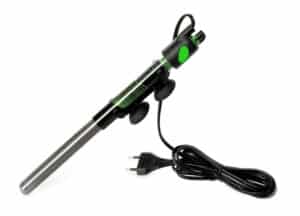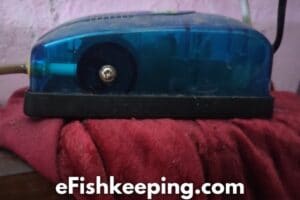Have you ever seen those tiny bubbles traveling upwards from stone-like structures and popping at the water surface of the aquariums? It’s nothing but air stones!
I’m sure you have seen it in aquariums at pet shops, your friend’s house, or in a restaurant. Keep reading till the end, as I will share everything you need to know about it.

What Is An Air Stone In An Aquarium?
At the end of the airline tubing, a porous stone is attached to oxygenate the tank and create beautiful bubbles – it is known as an air stone or aquarium bubbler.
There are porous stones of different sizes and types, some producing larger bubbles and others smaller.
Some types create a kind of ‘bubble curtain.’ Thoroughly analyze the market models to have the best choice.
Also, you must note the amount and size of bubbles since a lot of movement in the water column can disturb some species of fish, mainly those that inhabit more still waters.
Now, let’s talk regarding the placement of the air stone in an aquarium.
Where To Place An Air Stone In An Aquarium?

Generally, place the air stone near the tank’s base. Moreover, if there are numerous spots in your aquarium with minimal water circulation, producing still water zones, position the air stone in those places.
Putting the air stone strategically inside the aquarium will help prevent dead water space and ensure proper water circulation.
Dead water zones in the tank are the areas that don’t receive much water flow, and hence all the dust and food particles tend to collect there. All the collected waste provides a good place for algae to grow.
So placing the air stone in such stagnant water zones is a good idea to ensure proper water circulation inside the tank.
Also, avoid burying the air stone into the substrate because they won’t be able to function properly and produce bubbles. The substrate will cover up the small pores of the air stone from where air bubbles come out.
Now, I know you might also be wondering:
Should I place the air stone closer to the corner of the tank, or should I place it in the central region? And the answer to that mainly depends on your personal preference.
The primary purpose of an air stone is to create bubbles inside the tank. These bubbles rise and pop on the surface. Then, the surface agitation happens, and the gaseous exchange takes place, ultimately promoting oxygen’s entrance into the tank.
As a rule of thumb, you shouldn’t worry much whether you place the air stone in the corner part of the tank or the central part because, more or less, their output would be the same – to produce bubbles and agitate the water surface!
In our home aquariums, we place the air stones in the corner or central part of the tank depending on the other decoration setup and available space.
As long as the air stone remains closer to the tank base in a stable state, we don’t give it extra thought.
And following this principle, we never noticed any serious issues like the fish gasping for air and coming to the surface with this setup.
The fish sometimes gasp, but it happens for a different reason – for example when the air stone stops working. But other than that, everything works well.
For the most part, as long as the air stone produces bubbles and the water movement happens at the top surface, you are fine with the air stone placement and setup!
How To Place Air Stone In An Aquarium?
- If you got a new air stone, pre-soak it in the aquarium water for some time.
- Then, take an airline tubing and connect its one end to the air pump.
- Take the other end of the airline tubing and connect the air stone to it.
- Dip the newly connected air stone inside the aquarium water near the substrate.
- Turn on the air pump, and your air stone is ready to use, and enjoy the bubbles.
There are not many bells and whistles when setting up an air stone. You already know most of the process if you have previously set up a sponge filter with an air pump.
And even if you haven’t done it, don’t worry; the process is straightforward – connect the tubing with the end of the air stone, and it should start working!
Are Air Stones Worth It For Aquariums?
Yes, air stones are totally worth it to have in your aquarium, and here’s why:
- Air stone helps in oxygenating the tank.
- It creates beautiful bubbles inside the tank.
- It helps in circulating the tank water.
- It can also act as a source of entertainment for some fish.
Some fish like to play with water bubbles and the generated water movement in the tank.
For instance, aquarium fish like clown loaches, play with water movement in the tank. In our home aquarium, we constantly see them swimming and playing around near the outlet of the filter from where a steady stream of water flows.
Why Do Air Stones Stop Working?
If an air stone is not working or suddenly stops working, it can be either of the following reasons:
- The air pump is not able to pump air or is faulty.
- The airline tubing is clogged with dirt.
- The air stone is clogged with dirt and debris.
To solve this issue, try investigating the air pump. Is it working fine? Check if the air is flowing properly through the airline tubing.
See Related: Where Should You Place An Air Pump?
And if neither the air pump nor the airline tubing is the cause, then the air stone is the root cause of the issue.
You can put it inside boiling water for a few minutes and check if the air stone is working.
If the air stone still seems clogged, try soaking it in a bleach solution for about a day. Ensure to properly remove the residual bleach solution from the air stone before using it in the aquarium.
Generally, if you have more air stones at home, then using a new air stone would be more worthwhile than going through all the hassle of clearing dirt from the old air stone.
Air Stone Vs. Bubble Wall: Which One Should You Get?

An Air stone or bubbler is simply a porous stone from where air bubbles are released inside the tank.
On the other hand, as the name suggests, a bubble wall is an elongated, horizontal structure that produces a stream of bubbles through its many pores.
Since all bubbles are released so closely, it appears like a wall of bubbles is flowing upwards in the tank.
You can put either of them in your tank based on your personal preference regarding the aesthetics of the tank. Usually, a bubble wall is more suitable if you have a long horizontal-shaped tank.
As a general rule, a bubble wall is not suitable for a small vertical-shaped tank because if you have a bubble wall that covers the tank’s full bottom surface and you turn it on, all you would see is bubbles everywhere in the tank.
So, for small and average-sized tanks, an air stone producing a nice slender stream of air bubbles is more suitable. On the other hand, a bubble wall that produces a curtain of bubbles is preferable for longer aquariums.
Recommended Posts For You To Read:
Hi! I’m Praveen Ghoshal, the founder of eFishkeeping.com. Inspired by my Dad, I got interested in fishkeeping when I was a kid. Since then, I have been involved with this hobby. Currently, I have 3 fish tanks at our home, and I enjoy this hobby with my full family. Read more about me here.







